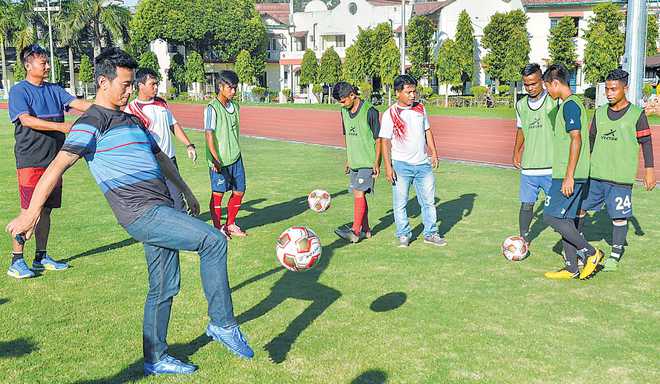
GAME ON: Access to quality coaching and infrastructure is a must for beginners.
Pradeep Magazine
CROATIA, a tiny East European country with a population less than 50 lakh, and an economy that is ranked 77th in the world, has become the toast of the world for its outstanding performance in World Cup football, making its entry into the final and winning adulation of people across the globe. For a country whose people number far less than any big Indian city, its sporting achievements far outstrip India’s, though it may lag behind India in GDP and economic growth. Croatia won five gold medals in the last two Olympics, just one less than what India has been able to manage in all the Olympics put together.
It is in times like these that India periodically wakes up to the reality that its pretensions of being a global power mean little as long as it remains on the margins of international sporting glory. A nation which is a nuclear power and is outperforming developed countries in economic growth makes up the rear as far as sporting achievements are concerned. It is an embarrassing reality which to many outsiders defies logic.
Why is a country like Croatia, ravaged by war that resulted after its separation from Yugoslavia, managing to produce world champions and emerging among the best in football, whereas India is languishing at the 97 rank? The way Indian football is stagnating, or maybe crawling upwards on this steep and long ladder, even another 100 years may not be enough for it to qualify for the World Cup, let alone win it. Similar would be the story in the Olympic Games, where India does win an odd medal or two, but to compete with top nations and finish anywhere in the top 10 would require a miracle.
To find an answer to this complex issue, let us first see what Croatia has that India lacks. It was part of the East European communist bloc when part of Yugoslavia and that means it inherited a strong sporting legacy. The communist nations spent huge amounts of money in building a sporting ethos which aimed at winning international competitions. It was part of their huge propaganda machine that wanted to tell the world how strong they were as nation states; as good, if not better, than the capitalist regimes. This also means Croatia has a better sporting infrastructure, though not as good as many European nations, but certainly far superior to what India has to offer its people. It may lag behind India in GDP numbers, but its average calorie intake is 2,900 kilocalories in comparison to India’s 2,360. The average height of a Croatian male is around 6 feet and for women it is 5.6 feet. The point of this comparison is to just show that a Croatian citizen is far better looked after, and when provided proper coaching, infrastructure and access to sports, the results are bound to be better.
Empty stomachs produce more “criminals” than model citizens, and certainly poor sportspersons. However, the argument here against labelling India a poor country struggling to feed its poor would be that there are more well-off, rich Indians who can afford to play sports, than in even developed countries. And India is no longer poverty ridden as it was in the past, though gross inequality has only grown, instead of reducing.
The counterargument, and it has its basis in valid studies, is that the upper middle classes and rich anywhere in the world prefer the comforts of life to sweating out and labouring to master a sporting discipline. The Messis and Peles of this world were plucked out of poverty and provided all the grooming, infrastructure and support, so that their talent blossomed. In contrast, the vast majority of Indians have no access to sports and if a rare champion emerges, his story is always the same. He or she has managed to succeed in spite of the system, not because of it. Be it India’s only Olympics gold medallist Abhinav Bindra or gymnastics sensation Dipa Karmarkar. Bindra used his parents’ money to fulfil his medal dream while Dipa overcame infrastructural hurdles and systemic shortcomings to emerge among the best gymnasts in the world.
The Indian sports story is a long list of nepotism, corruption, apathy from the system and selfish federation officials who can’t look beyond their nose. The government spending on sports, particularly infrastructure, is abysmal, though in the last decade or so, it has woken up to the fact — as the erstwhile communist regimes did — that sport has tremendous propaganda value and fuels “nationalism” as nothing else can.
Private enterprise too is doing its bit, though it has severe limitations. For most big businessmen sports is an opportunity to build their brands, hence they spend money on those who are already finding their way to the top. What is required is to level the bottom, provide access to good quality coaching and infrastructure to those who are beginners and not only those who already have shown the potential to do well.
Each time an Indian does well, beats the system to win laurels at a world meet, like Hima Das did recently by winning the gold in the under-20 World Athletics Championship, we all feel India’s time has come. Not really. This extremely cricket-plagued nation, a sport played by only a handful of countries who were under colonial rule, will have to find ways and means to spread the economic pie far and wide, in providing sporting infrastructure to its people. As long as the foundations remain weak, no amount of repair at the top can help to strengthen a building.
Senior sports journalist



























